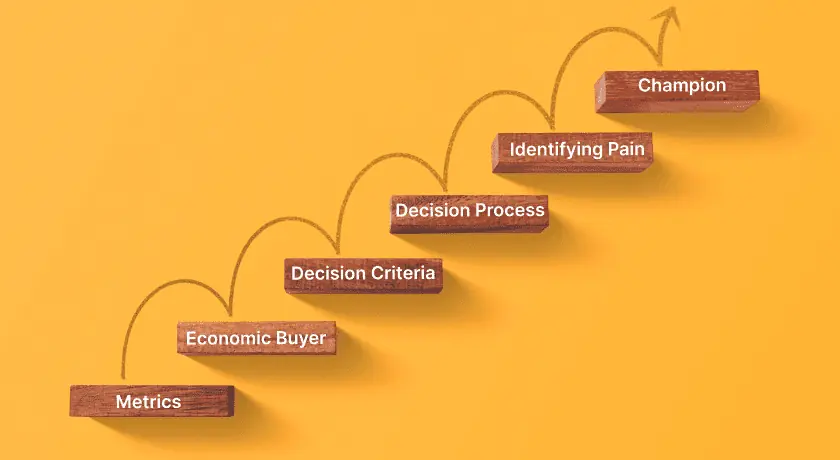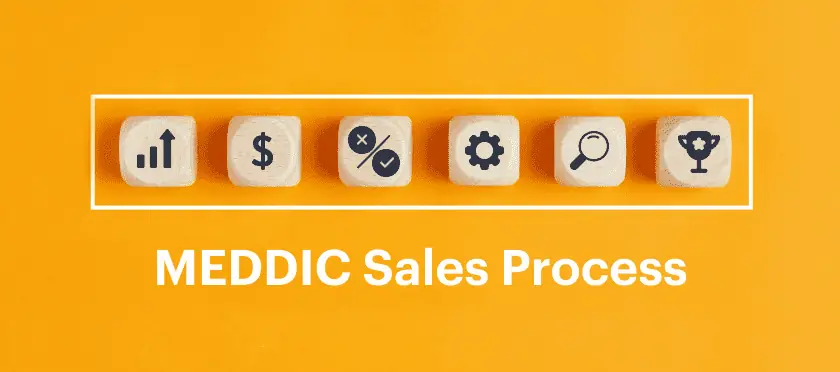The MEDDIC sales process is a highly-organized, structured approach to selling. It ensures sales reps and clients are on the same page about needs and expectations. However, since MEDDIC has several steps, it isn’t easy to apply if you don’t have a thoughtful action plan.
In this article, we’ll walk you through everything you need to know about the MEDDIC sales process and how to use it effectively for your business.
What Is the MEDDIC Sales Process?
Simply put, MEDDIC is a sales process that can help you identify the best way to engage with your target audience. It stands for Metrics, Economic Buyer, Decision Criteria, Decision Process, Identifying Pain, and Champion. Let’s go through each of these.
METRICS
A metric is a standard by which something can be measured. Metrics can be used to compare different options or evaluate performance. In a B2B setting, metrics can be used to assess potential customers’ needs and determine whether they are qualified or disqualified as leads.
ECONOMIC BUYER
An economic buyer is someone who has the power to make purchasing decisions within their organization. Economic buyers often have control over budgeting planning, so it’s crucial for a sales rep to understand who within their target customer base has this authority over spending decisions. This information can help salespeople figure out how best to approach each prospect.
DECISION CRITERIA
When evaluating purchase options, buyers look at several factors to make a buying decision, including cost, quality, and features offered by different vendors. Sales reps should understand these factors to deliver value propositions that resonate with customers’ needs.
DECISION PROCESS
Once you know what criteria a prospect uses to decide to buy, you should look at their decision process: where it starts, how long it takes, who participates in it, and so on. This information will help you put together a compelling pitch that fits into their existing processes while still focusing on what they care most about.
IDENTIFYING PAIN
Pain points are issues that are preventing your target audience from achieving their goals or being happy with their current situation. You should also consider how they might feel if they were able to solve a pain point—would they be excited? Satisfied? Disappointed? Whatever it is, identify it, and you’ll find it easier to connect with your prospects.
CHAMPION
Champions are people who have significant influence and respect within the organization. They have successfully executed projects in the past and care about resolving business pain. Champions are the linchpin of your whole sales process, so it’s essential to identify them early on and nurture them throughout the process.
MEDDIC Sales Process Pros and Cons
MEDDIC Sales Process Pros
- It’s a detailed checklist that can help you avoid missing out on important aspects of the sales process.
- It’s easy to follow and understand, even for beginners in sales.
- It provides a framework that you can use to develop new ideas and innovations as you progress through each stage of the sales funnel.
- It ensures all team members are working towards the same goals, leading to improved efficiency and productivity within your organization.
MEDDIC Sales Process Cons
- It can take a long time to complete because it has several steps to get started with each new prospect. If you don’t track how far along your prospect is in their journey, it can be easy to lose them before they’ve made it through all the steps to becoming a customer.
Why Use MEDDIC Sales Process?
As mentioned above, the MEDDIC sales process helps you identify prospects’ needs and wants to provide them with a suitable solution. This method is helpful to all sales reps, regardless of skills and experience.
Three key benefits of the MEDDIC sales process:
- Define ideal customers and their pain points.
- Create a solution that solves their problems while highlighting your company’s strengths.
- Get them excited about working with you so they’re happy to buy from you instead of your competitors.
MEDDIC vs. MEDDICC vs. MEDDPICC: What’s The Difference?
The big difference between MEDDIC, MEDDICC, and MEDDPICC is the addition of two components: Competition and Paperwork.
- Paper Process: The paper process is already a part of the original MEDDIC process. However, if many documents must be filled out before the contract can be awarded, you should make it a separate step.
- Competition: Know who your competitors are and what they’re offering. This will help you ensure your product/service is unique and different from what’s already out there.
If you’re selling to smaller companies, adding these components to your sales process may not be necessary. However, if you’re selling to larger corporations or government entities, it’s important to consider including them.
How to Implement the MEDDIC Sales Methodology?
1. Get Full Buy-in from Sales Managers
Before you implement the method, it’s important to get full buy-in from your sales managers.
Don’t just send your sales leads a memo about the methodology and expect them to follow it. Instead, ensure they’re on board with everything you want and how you want to do it. If you don’t have this support, it can be hard for you to see significant results from using the MEDDIC method.
2. Review Sales Objections and Win-loss Data
Looking at historic sales objections and win-loss data will help you identify where your salespeople are most likely to encounter objections and losses. This information will be useful for planning future sales calls, training sessions, or other activities.
3. Update Buyer Personas
To use the MEDDIC sales method effectively, you need to understand who your buyers are and their needs clearly. You can create at least three personas for each of your customers: one who buys from you, one who wants to purchase from you but doesn’t yet do so, and one who has already bought from you and is now looking for more products or services. Each persona will have different needs, meaning you should treat them differently.
MEDDIC Sales Method Alternatives
MEDDIC isn’t the only effective method of selling. You can also try other methodologies like conceptual selling, which emphasizes listening to customers and understanding their needs and wants rather than focusing on product features and benefits.
To learn more about sales methods, read our detailed blueprint for selling.


